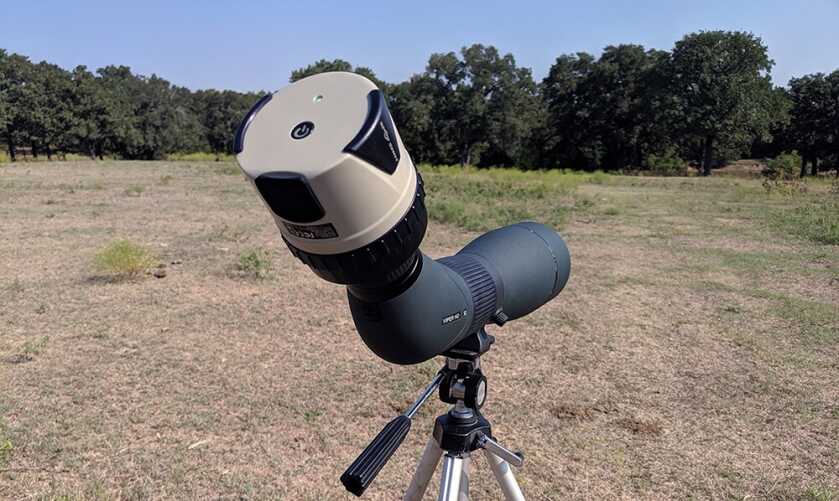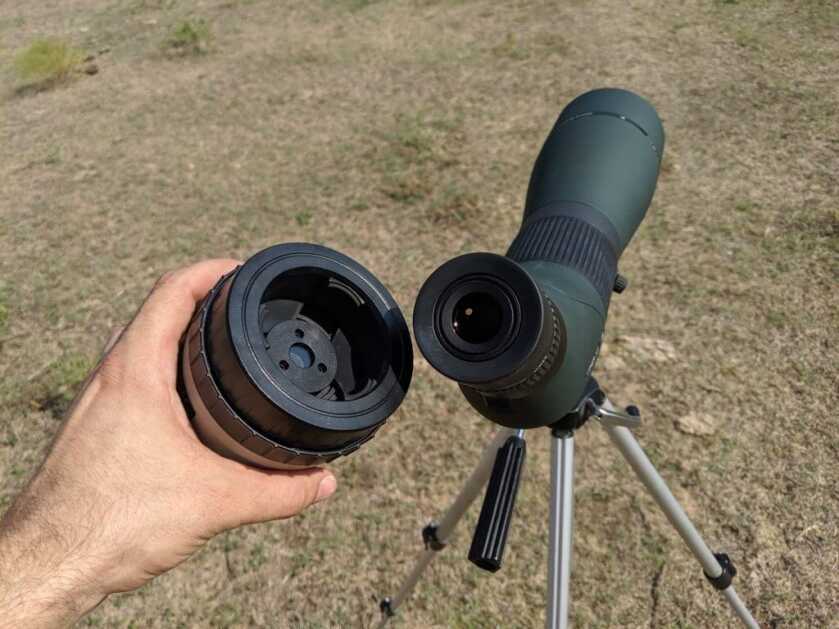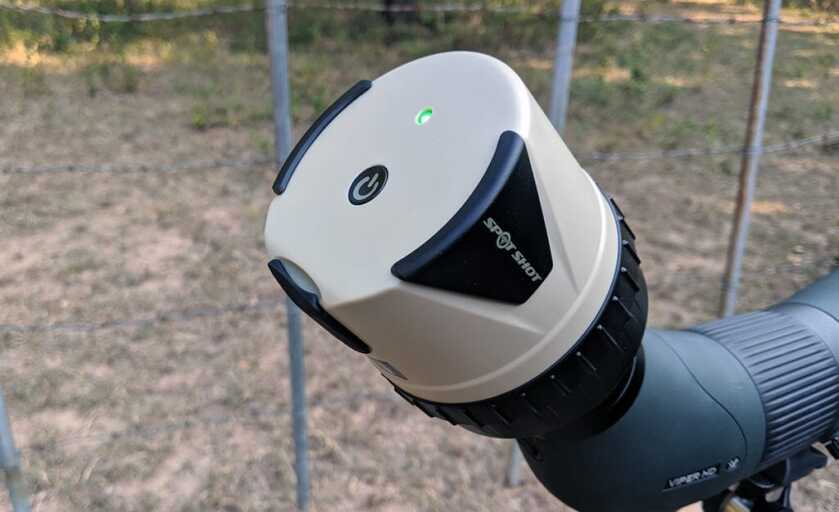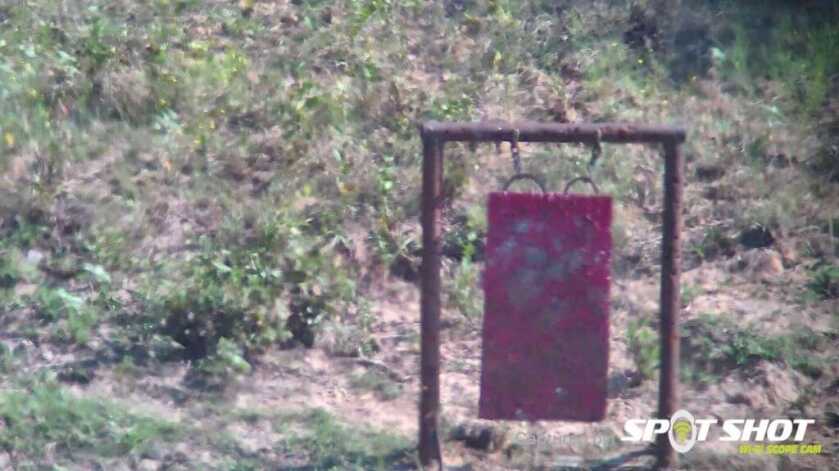
Shooting at long distances without a spotter is by far the best way to waste expensive ammunition. You might as well be shooting at night. You can get away with it if you’re using a rifle that lets you keep the scope on target, but otherwise, good luck. Trust me—I’ve been there.
The solution is to find a friend who doesn’t mind sitting behind a spotting scope. A good spotter can provide quick, reliable information—“You’re two feet high and half a foot left”—so you can adjust your point of aim before the wind changes.
But I don’t have friends. At least, none that are willing to spend an afternoon at the range on a weekday. (It’s a tough life being a gun writer.) That’s why I was intrigued by the Spot Shot Wi-Fi Scope Cam from Shooting Made Easy.
The Spot Shot is a Wi-Fi camera that can attach to virtually any spotting scope to take photos and videos of whatever you happen to be shooting at. Plus, unlike many products in the firearms world, it’s relatively inexpensive: MSRP is $119.99, but I’ve seen it for as little as $74.99.
Features/Specifications
- Live Streaming HD Video
- Universally mounts to a wide array of existing spotting scopes (1.0 – 1.5in diameter eyepiece)
- Rechargeable LiPo Battery (estimated 1500mAh for 8-10 hour battery life)
- Micro USB Charging Port
- Power Button with low battery indicator
- Compatible with current Bullseye app
- Micro USB cable (power only)
- Microfiber cloth
- Black carry pouch
Setup
The Spot Shot installs on any 1-1.5in diameter eyepiece and connects to your phone via the SME Spot Shot app. I found the former installation easier than the latter.
The camera attaches to the spotting scope eyepiece with a rotating collar that constricts and expands three rubberized feet. The feet squeeze the eyepiece and keep the camera securely attached even while moving a tripod.


After downloading the SME Spot Shot app to my Google Pixel 3, I powered up the camera and connected my phone to the Spot Shot’s Wi-Fi signal. Opening the app provides an option to “Connect,” but each time I tried, my app displayed the message “Cannot proceed with Wi-Fi.” Repeating this process with my wife’s iPhone 7 yielded better results. The app connected immediately, and I was able to navigate to options for taking photos and recording video.
(Update: I contacted SME’s support team, and they said the app might not work with Google Pixel 3’s. They’re looking into the problem, but if you have one of Google’s new phones, you might want to steer clear of the Spot Shot for now.)
Shoot, View, and Record Group Sizes
I see two primary applications for the Spot Shot, both of which I’ve been testing over the last few months.
First, the Spot Shot is handy for viewing and recording shot groups at a public range. The ability to take photos of targets allows users to record and analyze group sizes without having to collect the physical paper target. I found this functionality to be helpful at a range, where it’s sometimes inconvenient to wait until a cease-fire or ask my fellow shooters to wait for me to collect my target.

It’s also nice when shooting groups with a red dot or other optics not able to see bullet holes at 100 yards. If you’re by yourself (no friends, remember?), it’s inconvenient to stand up or lean to the side to peer through a spotting scope after every shot or group. With my phone propped up in front of me, I was able to easily and quickly check my target even while shooting from the prone position.

A Virtual Spotter
But the Spot Shot’s real potential lies in its ability to record shots at long distances and provide shot placement information. Recoil might keep you from seeing a dust cloud through a riflescope, but a review of the footage could reveal where your last shot landed.
The camera worked precisely as advertised. The video function captured my shot placements, and I was able to review the footage moments after I had pulled the trigger.

There are some limitations, however. Picture quality will depend somewhat on the quality of your spotting scope, but looking through the Vortex Viper 20-60×85 I used provides a much sharper image than what you see in the video. Still, it’s possible to see the target at 600 yards, and moving out to 1000+ yards shouldn’t be an issue on a day with good visibility.
Besides, image wobble will obscure the target sooner than picture quality. This was my biggest frustration, and it’s the most common critique in online reviews of this product. Even a slight breeze shakes the camera, and on a windy day, it’s difficult to see your hits past about 500 yards.
Still, as you can see in the video below, a dust cloud is visible even on a windy day. On this day, the wind was blowing straight toward the camera at 10mph, and I was still able to see were my shots were landing, make a quick adjustment, and get on target. (This video is of targets at 330 yards).
Even at 650 yards on a windy day, it’s possible to see missed shots. This was my first shot at that distance, and this video helped me get on target without wasting any additional ammunition (look low and to the right of the largest round target).
I want to be clear: image wobble isn’t a fault of the camera, per se. A super-solid, high-quality tripod should help calm the shake, but it’s something to keep in mind if you haven’t already invested in a nice tripod.
Conclusion
It isn’t perfect, but for the money, I think the Spot Shot is worth it—especially if you do a lot of shooting by yourself. A good spotter is hard to find, as the saying goes, and the Spot Shot can play that role in a pinch.

AVOID Google Pixel phones if you want to sync shooting/hunting equipment. I have a Sig Sauer 2400 KBS and it would never sync with my Pixel Gen 1 phone for data input. Numerous calls to both Sig and Google engineers didn’t solve the issue and Sig suspected that Google intentionally altered the software to prevent syncing to firearms. Got a Samsung S9 now and it syncs fine
Thanks for the tip.
That’s wireless and not too expensive.
The wobble might be mitigated field expediently, by making an “inertial mass” balance on the scope tripod by hanging a mass by 550 cord (ammo boxes) dangled directly below the scope but off the ground. Keeps the tripod stable for long range obs.
Great idea. I may give that a shot and post and update.
If I missed this information in the article I apologize, but what sporting scope are you using and if you could redesign your system, what would you purchase to further improve it?
Hey, James. It is in the piece, but it’s easy to miss — I was using a Vortex Viper 20-80×85.
You’d probably have to construct one rather than purchase it, but I think some kind of wind screen would be useful. Image wobble due to wind was the biggest frustration, and it’d be nice to find some way of mitigating that. A really solid tripod might also keep the wobble to a minimum.